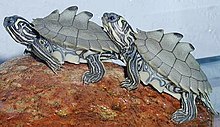Emydidae
| Emydidae Temporal range: 95–0 Ma Upper Cretaceous – Recent |
|
|---|---|
 |
|
| Black-knobbed map turtle | |
| Scientific classification | |
| Kingdom: | Animalia |
| Phylum: | Chordata |
| Class: | Reptilia |
| Order: | Testudines |
| Suborder: | Cryptodira |
| Superfamily: | Testudinoidea |
| Family: |
Emydidae (Rafinesque, 1815) |
| Subfamilies and genera | |
| Synonyms | |
|
|
The Emydidae, commonly called the pond turtles or marsh turtles, are a family of turtles. Previously, several species of Asian box turtles were classified in the family. However, revised taxonomy has separated them to a different family. Now, the Emydidae, with the exception of two species of pond turtles, are entirely a Western Hemisphere family. The family Emydidae includes close to 50 species in 10 genera.
The upper shell (carapace) of most emydids is the shape of a low arch, although in some species, it is domed. The upper shell may have one or two ridges that run from front to the back of the animal (a projection commonly called a "keel"), or such a feature may be absent. A prominent bridge often connects the top shell to the bottom shell (plastron). Emydids have large bottom shells, and some members of the family have a movable hinge that separates pectoral and abdominal segments (scutes). The skull is small.
The limbs of these turtles are adapted for swimming, with every member having some level of toe webbing.
Food habits range from strictly carnivorous to strictly herbivorous. The carnivores feed on annelids, crustaceans, and fish. In several species, a shift from carnivory in juveniles to herbivory in adults occurs. Small mammals, especially raccoons, are responsible for the destruction of many emydid nests. The wide range of sizes in mature animals leads to an assortment of predators. While snapping turtles are responsible for predation in some smaller species (e.g., Glyptemys muhlenbergii), they cannot eat larger species. Alligators pose a risk to adults of several species.
Knowledge of reproductive behavior ranges from some of the most detailed, long-term study of any taxon (Chrysemys picta in Michigan) to a total lack of information. In many species, dimorphisms include elongated foreclaws or a concave plastron in the male. The longer claws are used in a courtship routine in which the male faces the female and fans her face. The concave plastron allows the male to mount females in species with more domed carapaces (e.g., Terrapene). Reproduction is on an annual cycle, and multiple clutches may be produced in a single season. Clutch size is quite variable, ranging from as few as two to more than 30 eggs.
...
Wikipedia
